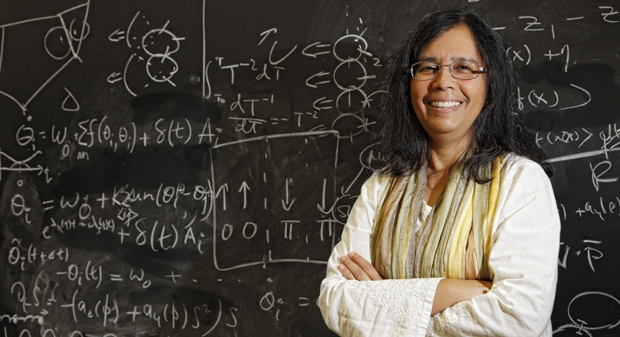Physicist Bulbul Chakraborty is finding equilibrium
The university's first female faculty member in physics hits her stride
 Photo/Mike Lovett
Photo/Mike LovettTheoretical physicist Bulbul Chakraborty is fascinated by the everyday: how sand behaves when pressed underfoot; how grain moves through a silo; how traffic jams occur. Sometimes using only pen and paper, the Enid and Nate Ancell Professor of Physics expends much intellectual energy unlocking the obscure physical secrets of the mundane.
But if the subjects of her sophisticated mathematical modeling seem routine, consider this: when grain in a silo transforms from a flowing, almost liquid-like state to a solid, jammed state, catastrophe can result, even causing the deaths of workers inside the hopper.
 Sand is arguably the archetypal granular material, capable of behaving in many different ways, not to mention a lovely ability to adopt elegant, sinuous patterns at the beach under the pressure of wind and water.
Sand is arguably the archetypal granular material, capable of behaving in many different ways, not to mention a lovely ability to adopt elegant, sinuous patterns at the beach under the pressure of wind and water.
“The surprising fact is that we do not really understand why sand behaves the way it does,” says Chakraborty, who has spent the last five years developing a theory of granular materials that can predict their collective behavior. “In the world of granular materials, gravity is important and temperature is not. This is stuff that we see around all around us but know very little about.”
In 1989, Chakraborty became the first woman to join the Brandeis physics department as a faculty member — a situation that has improved somewhat over the years with the hiring of several other female professors in this notoriously male-dominated field.
But the department has always been welcoming, Chakraborty says. She was encouraged by early Brandeis physicists like Stephan Berko, a founding member of the department who helped recruit her, and Bob Lange, who, she says, taught her everything she knows about teaching. In the last five years, she has gained particular traction in her research. Publication of her team’s paper, “Jamming By Shear,” in Nature in 2011 marked a turning point.
This month, one of her team’s studies, “Origin of Rigidity in Dry Granular Solids,” was accepted for publication in Physical Review Letters, a premier journal in the field.
“We have actually come up with a whole theoretical framework which has recently been tested very rigorously,” she says. “Essentially it’s like a whole other area of condensed matter physics, in its infancy,” which focuses on mechanical driving rather than thermal motion.
Born in India the youngest of six children, Chakraborty’s father encouraged her to leave home to study at an Indian institute of technology — where she was one of about 50 women out of 3,000 students — and then to apply to a PhD program in the U.S. At 20, she came to the U.S. and began her doctoral degree at Stony Brook in New York, where her husband also earned his PhD, but the two decided they’d return to India after each completing a post-doctoral fellowship. They did, and their son was born there, but they soon felt the U.S. pulling them back.
“It wasn’t that places in India were not doing good science, it was just that we had done all of our growing up here, and we didn’t know how to function in that environment.” It’s tougher to compete for research positions and to raise a family in India unless you subscribe to traditional lifestyles, she says.
When she arrived at Brandeis in 1989, she was already familiar with the singular life of the female scientist, and knew how important it was to bond with female colleagues outside of the Physics Department, where women were far outnumbered. Her counterparts at Brandeis in biology and math — Eve Marder and Ruth Charney — were great friends and resources. All three have played leadership roles for women in science, and all three have chaired their respective departments.
“Physics is still very much of an individual pursuit and I think that’s one reason women find it harder to do,” she says. “I think women, more than men, like to work in communities.
“I went through tenure essentially as a single mother because my husband was at Yale most of the time,” she says. “My advice to my graduate students is that if you are interested enough in what you’re doing, you’ll work it out. It’s not going to be the same algorithm for everyone.”
It wasn’t just her personal life that went through changes. While her career initially focused on superconductivity and hard condensed matter, she eventually moved into soft matter. Chakraborty, who has always enjoyed more “pen and paper stuff than lab” science, says the subject matter you work on has a lot to do with what interests your colleagues but she’s also had a lot of freedom to explore at Brandeis.
“I always like taking approaches that are different from others,” says Chakraborty, who hopes to continue mentoring other female physicists at Brandeis. “Sometimes that’s foolish, sometimes its not.”
Categories: Research, Science and Technology





